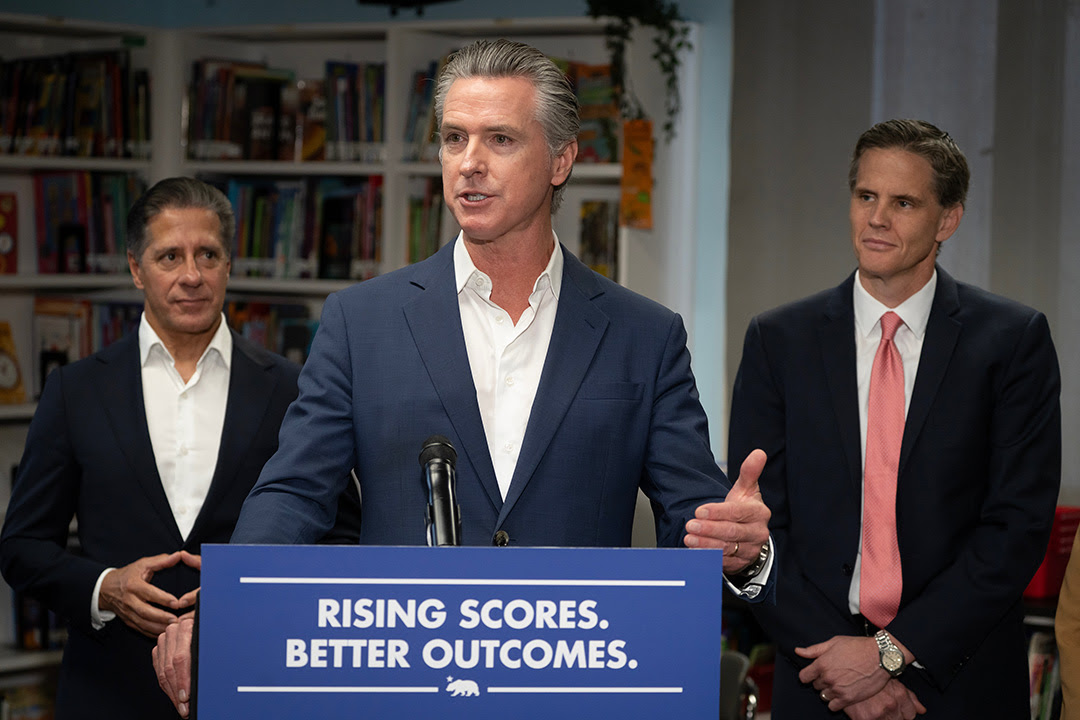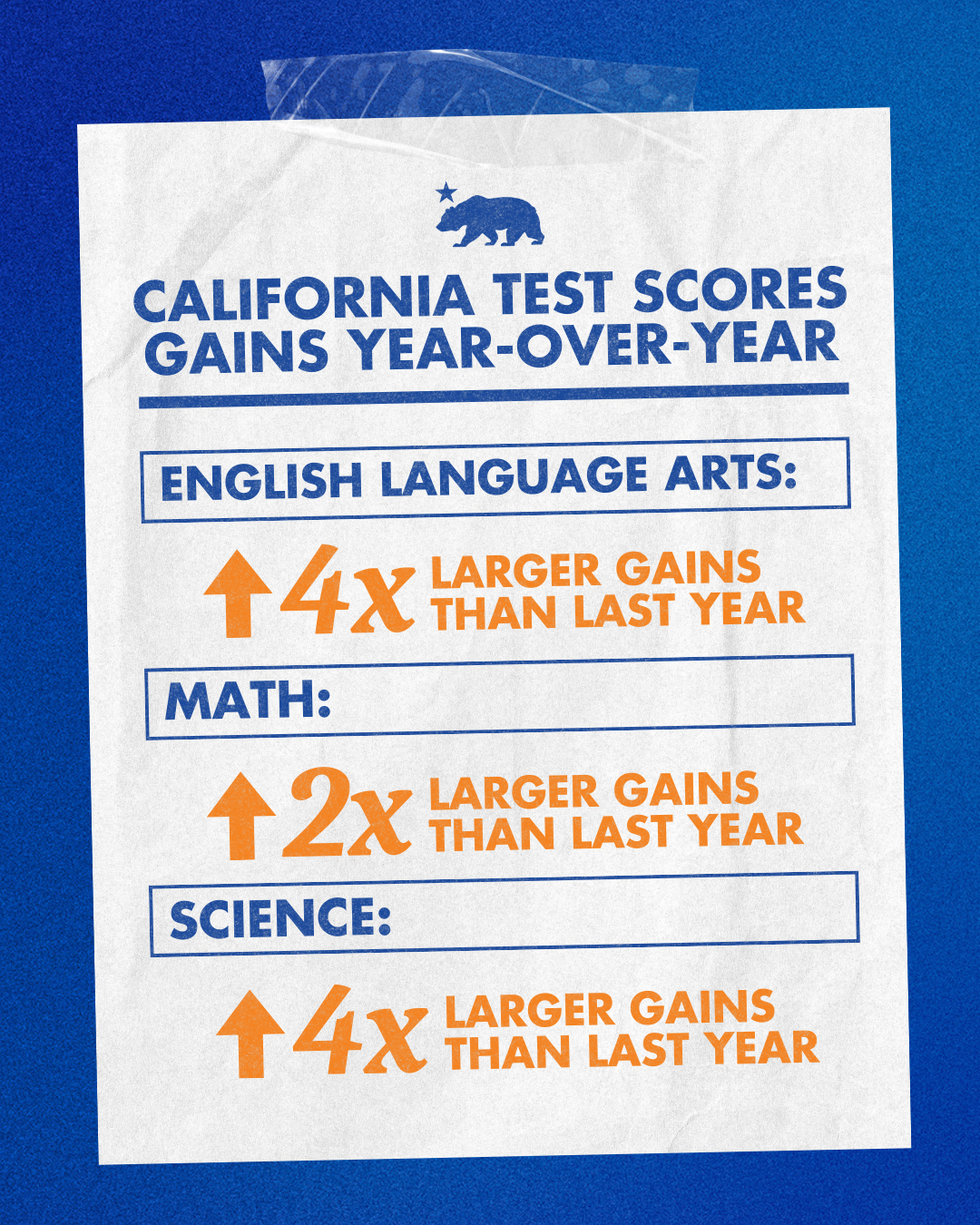
LOS ANGELES:- Governor Gavin Newsom today announced Californian student test scores for the 2024-2025 school year, which show significant continued progress made by K-12 students – with low-income students, Black students, and Latino students seeing particularly notable progress.
As part of his Golden State Literacy Plan to strengthen literacy, Governor Newsom also signed AB 1454 by Assembly Speaker Robert Rivas (D-Salinas), ensuring educators and school leaders have access to the tools, training, and resources needed to help students become better readers.
“Strong reading skills are the foundation for every student’s success, and this new law demonstrates a landmark commitment to advancing California’s reading and literacy rates,” said Speaker Robert Rivas (D-Salinas). “It is a critical step forward and will improve literacy outcomes for all of our students.”
The assessment results released today include data for the California Assessment of Student Performance and Progress (CAASPP) and the English Language Proficiency Assessments for California (ELPAC). Overall, the percentages of California students meeting or exceeding the proficiency standard – demonstrating proficient or advanced grade-level knowledge and skills – in English language arts (ELA), mathematics, and science showed increases at a higher rate than the year prior.
“California’s significant education investments like Universal Transitional Kindergarten, reading coaches, professional development, and community schools have boosted student proficiency in many areas,” said State Superintendent Tony Thurmond. “Some growth is modest and some is profound, but in all cases the data reflects the impact of these investments and the hard work of educators to help students succeed. We aspire to achieve even greater student outcomes. We are working to secure additional investments to support comprehensive, long-term, statewide strategies to further move the needle in student proficiency for years to come.”
In total, the proportion of students meeting grade level expectations (scoring at levels 2, 3 or 4) also grew to 70.6% in ELA, 61% in mathematics, and 86% in science. The proportion of students scoring at the “minimal” level on the test – not yet demonstrating a consistent mastery of grade-level knowledge and skills – decreased in each category to 29.4% in ELA; 39% in math, and 14% in science.
 Other data points of interest in the 2025 California assessment results include:
Other data points of interest in the 2025 California assessment results include:
Black or African American students and Hispanic or Latino students made higher-than-average improvements in ELA, math, and science.
Socioeconomically disadvantaged students showed modest gains in all three subjects.
“The release of California test data today shows our public schools are making noteworthy progress in key areas, with gains on all three major assessments,” said State Board of Education President Linda Darling-Hammond. “These gains are attributable in part to the Administration’s thoughtful and sustained investments to address inequities in life circumstances and educational opportunities for some of our state’s most vulnerable students through community schools, nutrition and mental health supports, and investments in learning recovery including literacy and math coaching, tutoring, and extended learning time. With continued work and focus in these areas, we’re hopeful for sustained future progress by all students.”
In many school districts across California, significant increases in student achievement tell a story about how targeted state investments and key programs can create a blueprint for how further acceleration of academic progress could occur statewide.
In the Los Angeles Unified School District, the rate of students meeting or exceeding standard (demonstrating proficient or advanced grade-level knowledge and skills) in ELA increased by 3.40 percentage points, Math by 3.93 percentage points, and Science by 3.32 percentage points, reaching the highest levels ever recorded for Los Angeles Unified since the state first launched the Smarter Balanced Assessment. Across all subjects and grade levels, student performance in 2024–25 not only surpassed results from the prior year but also exceeded pre-pandemic levels from 2018–19. Superintendent Alberto M. Carvalho credits this historic achievement to the hard work of educators, staff, and students, supported by targeted investments in early literacy, math intervention, and expanded science opportunities designed to accelerate learning and close gaps created by the pandemic. These efforts to raise achievement for every student have been strengthened by statewide funding and grants aimed at expanding access, equity, and excellence across all classrooms.
In the Compton Unified School District, the rate of students meeting or exceeding the proficiency standard (demonstrating proficient or advanced grade-level knowledge and skills) in ELA increased by 7.97 percentage points, as well as 6.42 percentage points in math, which Superintendent Darin Brawley credits to the hard work of educators, staff, and students as supported by districtwide implementation of biweekly performance tasks and common assessment cycles, building upon existing districtwide data systems and instructional strategies. These efforts to move the needle in ELA and math were funded by the district’s base grant and Local Control and Accountability Plan (LCAP) funding.
At Roseville Joint Union High, the rate of students meeting or exceeding the proficiency standard in ELA increased by 3.22 percentage points over the prior year, while the rate of students meeting or exceeding standard rose by 5.59 percentage points in math and by 2.62 percentage points in science. Superintendent Mike Kuhlman discussed a focus on community engagement and maximizing the educational achievement and opportunities of each of his students. To that end, El Dorado Union High has used its Learning Recovery Emergency Block Grant funding to support students and staff in recovering from the impact of the COVID-19 pandemic. This includes addressing learning gaps, promoting social-emotional well-being, and ensuring students are ready for the school year.
At Pittsburg Unified, the rate of students meeting or exceeding the proficiency standard in ELA increased by 4.64 percentage points over the prior year, while the rate of students meeting or exceeding standard rose by 1.53 percentage points in math and by 2.94 percentage points in science. In addition, students’ average scale score increased in every grade level and nearly every student demographic group for ELA and math. Superintendent Dr. Janet Schulze credits these increases to the hard work and brilliance of the scholars, teachers, and staff of Pittsburg Unified and their approach to teaching and learning, continuous improvement, and the needs of the whole child. The District is a Full-Service Community Schools District thanks to funding from the Community Schools Partnership Program. Targeted tutoring support for students has also proved impactful, benefitted by funding from California’s Expanded Learning Opportunity Program.
In the Sanger Unified School District, the rate of students meeting or exceeding standard (demonstrating proficient or advanced grade-level knowledge and skills) in English Language Arts increased by 4.29% percentage points, which Superintendent Dennis Wiechmann, Ed.D. credits the hard work of educators, staff, and students as supported by targeted funding for our early literacy initiatives – for ensuring that all students experience growth in literacy, with the district goal of every student advancing at least one grade level each year. These efforts to move the needle in English Language Arts were through funding from the California Department of Education’s Instructional Block Grant, the Learning Recovery Emergency Block Grant, and targeted Local Control and Accountability Plan (LCAP) funding—all focused on improving student achievement, supporting student growth, and closing the achievement gap.
Comments